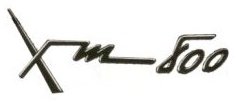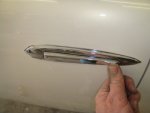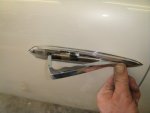
PAGE JUMPER
XM-800 INDEX PAGE 9 PAGE 10 PAGE 11

 CONCEPT CAR
CONCEPT CAR"An entirely new and advanced design, engineered to go into volume production after the completion of normal tooling, the Mercury Monterey XM-800 was introduced to the public in February 1954. The XM-800, which was created by stylists of Ford Motor Company's engineering staff in cooperation with Lincoln-Mercury product planning and production engineers, is not a sports car, nor is it a "dream" car of the distant future. Although it has features of both, these features have been combined into a startlingly new but readily producible automobile. A four-passenger hardtop coupe, the car is lower than any other American hardtop now being produced, with an overall height of only 55.6 inches. It maintains passenger comfort by means of a new frame construction and lowered rear floor, while it's low center of gravity gives better stability on the road. While the prototype display car had a fiberglass body, production units probably would be of steel. The XM-800 is mounted on a new chassis with a 119-inch wheelbase. In production it would be powered by an advanced design overhead valve V-8 engine. It's crisp, sweeping lines begin at the forward-canted headlamps and carry through to the twin tail lights isolating the center body area. The concave front grill represents an entirely new treatment and has the added advantage of providing a greater air flow for engine cooling. Engine performance also is improved by a functional air scoop on the plain-flowing hood. Noticeable is the absence of hood ornamentation. A forward sweeping pillar post supports the wide wrap around windshield, which is further enhanced by a chrome overlap of the roof. Graceful, sweeping body lines are emphasized by the absence of chrome side moldings, while flush type door handles were designed to flow with the body line. A chrome roof rail molding is carried from the windshield to the rear deck, and a wide band of chrome accents the division between the roof and the rear window. The rear of the XM-800 is featured by the severe angle of the quarter panels, the integral chrome impact bar with embedded dual exhausts, and the gently sloping deck lid. A radio antenna is centered on the deck lid. Painted in pearlescent white with a pearlescent copper colored roof, which sets the theme for an attractive interior two-tone combination of copper and white vinyl, the car features individually contoured seats front and rear. Stationary arm rests divide the seats and contain controls for the drivers four-way power seat, the front passengers reclining seat, electric window lifts, cigarette lighters and ash trays. The influence of aeronautics is evidenced in the design of the instrument panel. Clustered in front of the driver are gauges for water temperature, oil pressure, battery and fuel. Each of these gauges is monitored by a warning light which flashes red if the performance of any of these operations nears the danger point. A tachometer, a speedometer, an electric clock with a sweep second hand, and radio controls complete the panel. Other innovations in the XM-800 include a door-pull and door handle combined in a single built in unit, along with a fluted-type steering column. The car has power steering, power brakes and a Merc-O-Matic transmission. Specifications of the XM-800, as compared with those of the standard 1954 Mercury Monterey hardtop, follow:" Wheelbase 119 inches 118 inches Length 207.4 " 202.2 " Width 78.8 " 74.0 " Height 55.6 " 64.1 " Tread Front 58.0 " 58.0 " Rear 59.0 " 56.0 " Ground Clearance 7.0 " 8.3 " |
In the above release you saw that the XM-800 is 55.6" tall, that's 11.5" shorter than any other americar Hardtop, nearly a full foot! The XM-800 is also 5" wider and 5" longer than any other Ford product in 1954. It was the first Ford product with the forward sloping windshield pillars and wrap around windshield. A feature seen on nearly every car by 1957. It was the first car to have bucket seats front and rear, something not seen again in a production car until Pontiac used it in 1960. The most appreciated feature of the XM-800 from spectator responses while at the February 1954 Detroit Auto Show was the beautiful integration of the rear window with the body lines. The parking lights are built into the underside of the front bumper The XM-800 is the first Ford to use fins as a design feature which preempted the huge flaring fins of the later 1950's. Another innovative feature is the ability to raise and lower the hood and deck lids by the automatic lifts at the flick of a switch on the dashboard It was the first Ford product to use a tachometer in the dash. One publication described it as "an instrument that tells the driver how fast his engine is going in revolutions per minute" so you know it was a relatively new device. Although not many features on the XM-800 ever turned up on future Mercurys, the tail lights found themselves used on the '55 Lincoln. The fins are on the '57 Lincoln, the hooded headlights are on the 56 and 57 Lincolns, The ribbed roof band was used on the '56 Lincoln Landau, the skirted front fenders were used on the 56 Lincoln, the dog leg on the A pillar was used on many ford products as well as the wrap around windshield. And a version of the interior found itself in the '58 Thunderbird. I'll add pictures of these features as I get to them so keep checking back. In the text of the informational release above you read: "flush type door handles were designed to flow with the body line" Here is what they look like and they are absolutely wonderful!   (don't mind my dirty thumb in the pictures) PAGE 11 |